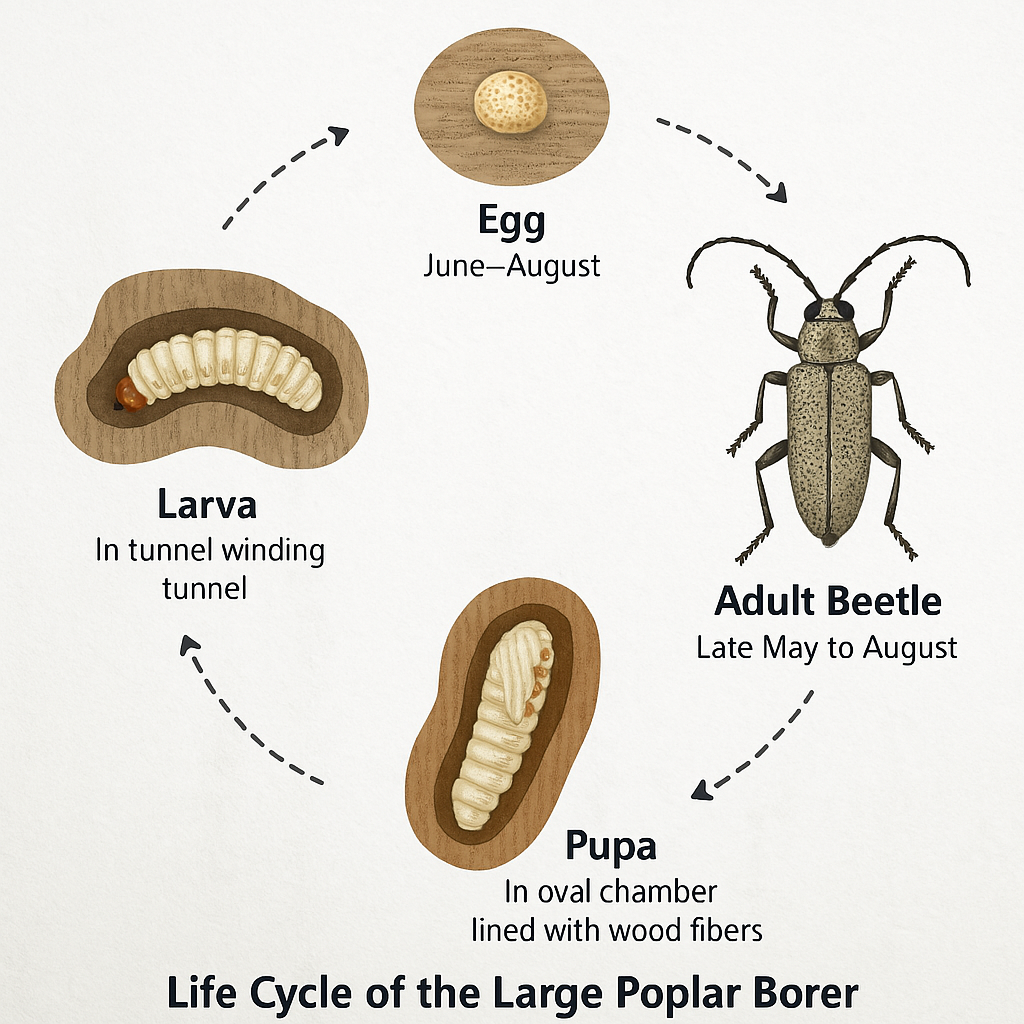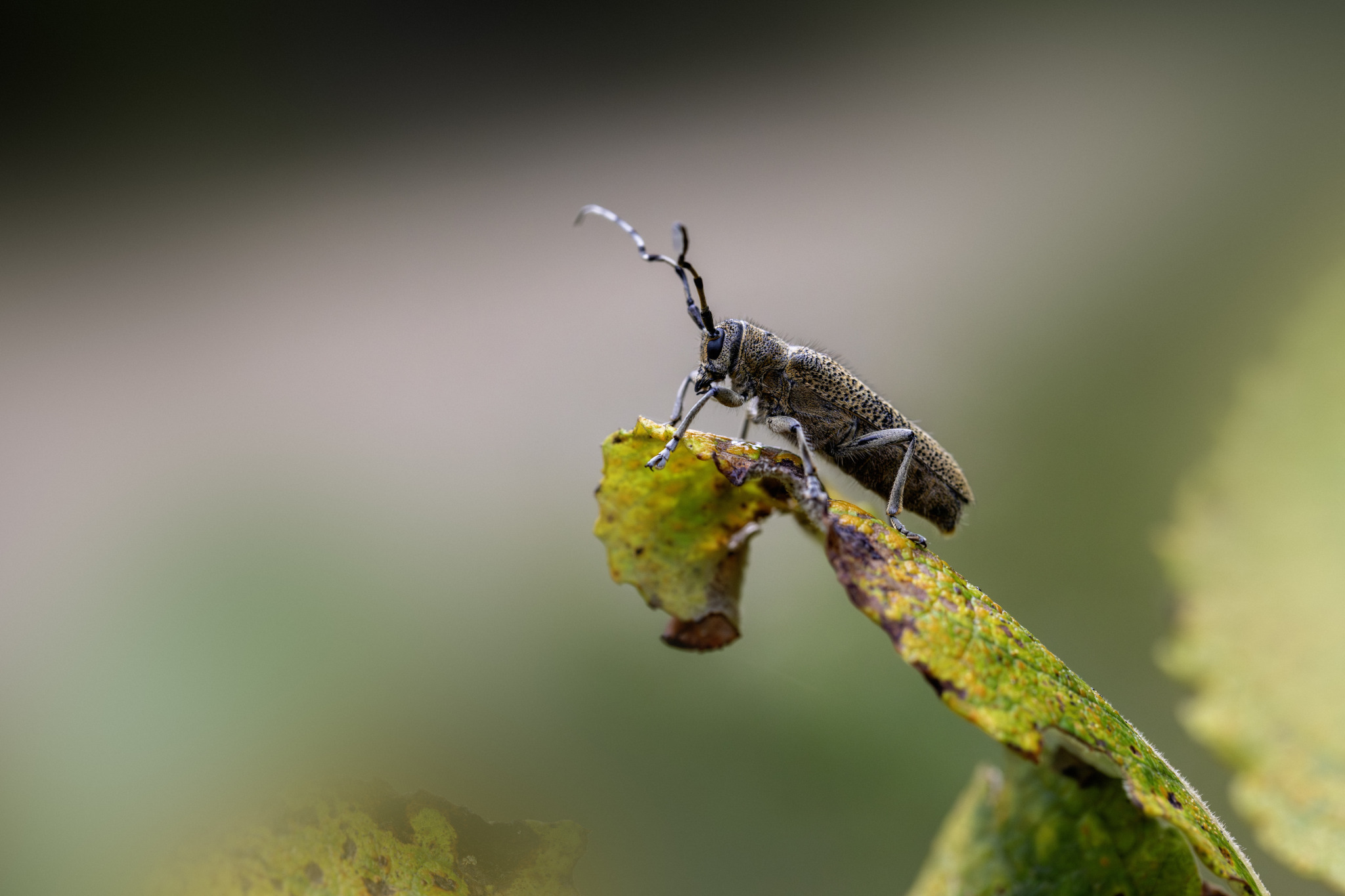🪵 Deep Overview: Large Poplar Borer / Longhorn Beetle (Saperda carcharias)
The Large poplar borer (Saperda carcharias) is a robust longhorn beetle known for its association with poplar trees—especially aspen and black poplar. As a member of the Cerambycidae family, it is distinguished by its long antennae, attractive coloration, and wood-boring larval stage, which can impact forestry and tree health.
Though not usually present in massive numbers, its larval tunneling can weaken or kill trees, making it a species of concern in both natural and managed forests.
🧬 Taxonomy & Classification
- Kingdom: Animalia
- Phylum: Arthropoda
- Class: Insecta
- Order: Coleoptera (beetles)
- Family: Cerambycidae (longhorn beetles)
- Genus: Saperda
- Species: Saperda carcharias
- Common Names:
- Large poplar borer
- Poplar longhorn beetle
🧍♂️ Physical Description
- Size:
- Adults: 17–27 mm long, one of the larger Saperda species
- Coloration:
- Pale bluish-gray to yellowish-gray body, with a fine dusting of golden or silvery hairs
- Two prominent dark eye spots near the head
- Antennae:
- Very long, often longer than the body—banded black and pale gray
- Larvae:
- Creamy white, legless, with a brownish head capsule
- Can grow up to 35 mm
- Pupa:
- Develops inside the wood in an oval chamber
🌍 Distribution & Habitat
- Native Range:
- Europe and Western Asia
- Extends into parts of Central Asia and Siberia
- Preferred Habitat:
- Lowland forests, riparian zones, parklands
- Found wherever host trees (poplars) grow—natural stands or plantations
- Often seen on mature poplars with thick bark
🌳 Host Plants
- Primary host: Populus spp. (poplars)
- Especially:
- Black poplar (Populus nigra)
- Aspen (Populus tremula)
- Especially:
- Occasionally found on willows or other hardwoods in proximity to poplars
🔁 Life Cycle
- Lifecycle Duration: 2–4 years, depending on climate and host condition
- Reproduction:
- Adults emerge from late May to August
- Mating takes place on trunks or branches
- Females chew small pits in bark to lay up to 100 eggs individually
- Larval Stage:
- Hatch after 1–2 weeks and begin boring into the bark, then deep into the heartwood
- Create extensive winding galleries, weakening structural integrity
- Larvae feed for 2–3 years
- Pupation:
- Occurs inside a chamber lined with wood fibers, near the bark surface
- Emergence:
- Adults chew an oval exit hole (8–10 mm) and fly to find mates and new host trees
🍽️ Feeding Behavior
- Adults:
- Do not feed much or at all—may take minimal sap or moisture
- Larvae:
- Primary feeding stage
- Bore through cambium and xylem, disrupting sap flow and weakening trees
🧠 Behavior & Ecology
- Activity:
- Adults are active in warm weather, primarily diurnal
- Can be found on tree trunks or resting on leaves
- Flight:
- Adults are strong fliers, though not long-distance dispersers
- Sound:
- Like many Cerambycids, larvae can produce audible scraping sounds when active
- Overwintering:
- Occurs as larvae inside trees
⚠️ Impact & Damage
- Ecological Impact:
- In natural settings, it plays a role in wood decomposition and nutrient cycling
- Forestry Impact:
- Considered a pest in poplar plantations
- Larval tunneling can lead to:
- Growth suppression
- Branch dieback
- Structural weakening
- Tree death in severe cases
- Exit holes and larval galleries reduce timber quality and market value
🛡️ Control & Management
- Monitoring:
- Look for oval exit holes, frass deposits, and larval galleries
- Adults can be spotted on trunks in summer
- Silviculture:
- Use resistant poplar varieties
- Remove infested trees to prevent spread
- Chemical Control:
- Systemic insecticides are rarely used due to environmental concerns
- Biological Control:
- Natural predators: woodpeckers, parasitic wasps, entomopathogenic fungi
- Encouraging these may help regulate populations naturally
🧠 Interesting Facts
- The long antennae help sense vibrations, host tree volatiles, and mates
- Unlike some longhorn beetles, adults are not brightly colored, but are subtly attractive up close
- Historically, they have been used in entomological studies of xylophagous (wood-eating) behavior
- Their galleries can sometimes be confused with those of bark beetles, but they are larger and deeper
📌 Conservation Note
While Saperda carcharias can be a local forestry pest, it is also part of native woodland ecosystems, especially in areas where deadwood and old trees are preserved. Conservation of biodiversity in managed forests requires a balance between economic concerns and habitat complexity.
📜 Conclusion
The Large poplar borer is a striking and ecologically impactful longhorn beetle. As a specialist on poplars, it illustrates the intricate relationship between insect life cycles and tree health. Though generally not a massive pest, in plantation forestry, it can be a concern. In natural forests, it serves a role in wood decomposition and supporting predator species. Knowing how to recognize and manage it is key for sustainable forestry and biodiversity conservation.
🔄 Life Cycle of the Large Poplar Borer (Saperda carcharias)
You can visualize the life cycle as a circular progression, typically taking 2–4 years to complete.
🟤 1. Egg Stage
- Timing: June–August
- Location: Laid in small chewed niches in the bark, especially on stressed or older poplar trees
- Appearance: Tiny, oval, creamy-white eggs
↓
🐛 2. Larva Stage (Main Feeding Phase)
- Duration: 2–3 years
- Behavior: Bores deep into the sapwood and heartwood, feeding on wood tissue
- Tunnel Shape: Long, winding, oval-shaped galleries filled with sawdust-like frass
- Overwintering Stage: Larva
↓
🦋 3. Pupa Stage
- Timing: Spring (year 2 or 3)
- Location: Within the gallery, in a special oval chamber lined with wood fibers
- Metamorphosis: Lasts 3–6 weeks depending on temperature
↓
🪲 4. Adult Beetle Emerges
- Timing: Late May to August
- Emergence Mark: Clean oval exit hole (8–10 mm), usually on the lower trunk
- Behavior: Mating and dispersal; short-lived as adults
- Antennae: Prominent and ringed, longer in males
↓
…and the cycle repeats.
🆚 Comparison with Similar Longhorn Beetles
| Feature | Saperda carcharias | Saperda populnea (Small poplar borer) | Monochamus spp. (Pine sawyers) |
|---|---|---|---|
| Size | 17–27 mm (large) | 8–12 mm (small) | 15–30 mm |
| Host tree | Poplar species | Poplar & willow | Pines (not poplars) |
| Exit hole shape | Oval (~8–10 mm) | Round (~3 mm) | Oval, often larger |
| Body color | Pale bluish or gray with fuzz | Yellowish with black dots | Dark brown to black |
| Larval tunnel depth | Deep into heartwood | Stays more in cambium/phloem | Deep into xylem, with frass trails |
| Flight season | June–August | May–July | Varies (mostly summer) |
🔎 Identifying Larval Signs in Wood (Field Guide Style)
Here’s what to look for if you suspect S. carcharias infestation in poplars:
✅ External Signs
- Frass/Sawdust: Accumulating at the base of the trunk or emerging from small bark cracks
- Oval exit holes: 8–10 mm long, clean-cut, mostly on lower trunk
- Weakened bark: May look cracked or sunken
- Oozing sap: Sometimes a sticky dark sap is seen near entry points
🪵 Internal Signs (if bark is removed or in cut timber)
- Tunnels: Wide (up to 10 mm), winding, and filled with compacted frass
- Chambers: Pupation cells lined with wood fibers or shredded material
- Galleries go deep into the wood—much deeper than bark beetles or small borers
Pro tip: The presence of oval exit holes near the base + golden-grey beetles nearby = strong indicator of active S. carcharias population.

Views: 477
Subscribe to the newsletter:
